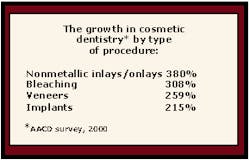Cosmetic dentistry: The "boom" is upon us!
In the first of three articles, the authors explore the relationship between the increasing demand for cosmetic services and the aging of America's most dominant demographic — the baby boomers.
by Cindy Hearn & Doug Hammond
Every dentist practicing today has — in some way — been affected by the recent increase in demand for cosmetic procedures. By some estimates, the dollars spent on cosmetic dentistry have more than doubled in the past five years. That's pretty significant. According to a recent American Academy of Cosmetic Dentistry (AACD) survey, most procedures have experienced phenomenal growth, typically in excess of 200 percent. Nonmetallic inlays/onlays lead the way, with an increase of 380 percent! Whitening/bleaching is the most requested procedure, while veneers, tooth-colored inlays/onlays, tooth-colored crowns, and bonding round out the top five.
So, what's been influencing this recent boom in cosmetic dentistry? One major factor contributing to the growth is the undeniable fact that the American population is aging. One of the largest and most famous population groups in our history, the baby boomers, is growing older. And so are their teeth. But unlike generations before them, or those that follow, baby boomers have unique characteristics that make them ideal cosmetic candidates. As noted by Dr. Stephen Eklund, adjunct professor at the University of Michigan School of Dentistry, "Baby boomers have been, and will continue to be, major consumers of dental care." In fact, according to the AACD, the majority of cosmetic patients fall in the 40-49 age category (26.88 percent), followed by the 50-plus segment (25.09 percent). Females represent 71 percent of these patients and lead the demand. So who, exactly, are the baby boomers? How can practices help meet this increasing demand and help the boomers get the dentistry they want and need?
The beautiful boomers
Appearance and beauty have always been important in American culture, and even more so to the "me generation." Now, the generation that vowed never to trust anyone over 30 is entering their mature years. Thanks to this group, the face of aging is changing. Forty is no longer considered "middle-aged." Not only do baby boomers feel younger than their true age, but due to medical advances, they are living healthier, more active, and younger lifestyles.
In fact, according to the American Association for Retired Persons (AARP), the median age of the average boomer is 42; yet the typical boomer feels much younger. "Ask almost anyone you know who is over the age of 40 to tell you what they think a stranger would guess their age to be. Based on attitude, health, appearance and lifestyle, it will be, on average, seven to 10 years younger than their actual, chronological age," adds Frank Conaway, president of Primelife and a mature market expert. "Baby boomers are not going to 'age gracefully,' but they will age beautifully. They will go into maturity kicking and screaming all the way, and they will do whatever they can to challenge the stereotypes, and realities, of aging." So, it truly won't be long before the image of the typical grandmother baking cookies and rocking on the porch will be permanently replaced by that of a vivacious role model who is as adept on rollerblades as she is in the kitchen, making a gourmet, health conscious, low-calorie meal.
Along with this young attitude and lifestyle comes this generation's desire to maintain a youthful appearance. According to the American Society for Plastic Surgery (ASPS), the 35-to-50-year-old age group is the largest plastic surgery market, accounting for 43 percent of procedures performed today. And, similar to cosmetic dentistry, the recent boom in plastic surgery is illustrated by the 47 percent increase in procedures requested by 51 to 64 year olds reported by the ASPS.
So, what is the connection between the increase in plastic surgery, the aging of the baby boomers, and the increase in mostly cosmetic dental procedures?
Obviously, a smile is an important part of a person's overall appearance. According to www.nbc6.com, 92 percent of people surveyed said an attractive smile is an important social asset; 74 percent believe an unattractive smile could hurt one's chances of career success. Despite these increases in plastic surgery, the fact that one-half of all adults are not content with their teeth, many, according to Innex Health, are unwilling to pay the higher price or invest the time for orthodontic work or facial plastic surgery. Cosmetic dentistry presents a reasonable, affordable, and attractive alternative.
A perfect match
Natural and physical changes occur with age. Every person will experience these changes; the only variable is to what extent and when. These changes include vision and hearing loss, bone density and muscle loss, and diminished dexterity and strength. Aging teeth typically fade to a yellowish tone. Decay and wear and tear further contribute to a less-than-youthful appearance. Advances in dentistry — such as laser whitening, natural-colored inlays/onlays and crowns, and veneers — have made it possible to help baby boomers and their aging teeth look young again. As children, baby boomers didn't have the cavity prevention and pain assistance available to patients today. Consequently, a large percentage of this demographic has a deep-seated aversion to dentistry. Back in the "old" days, when "Look, ma, no cavities!" was the leading toothpaste's slogan, boomers came to the dental office for fillings. And the visits were typically unpleasant. "I remember trips to the dentist when I was younger," recounts Warren Vickery, age 40. "My teeth were prone to cavities; I have a mouth full of silver fillings. After high school, I put years between each dental visit; I'm just now getting the comprehensive dental care I need."
Current trends indicate that baby boomers are ready to put aside their long-term fear of dentists and brave the chair to get that radiant, white, and healthy smile that fits their image and lifestyle. Advances in products and pain assistance have made dentistry a totally different experience. Even with these advances, according to the AACD survey, pain is one of the primary reservations patients have with cosmetic procedures. Other concerns include time and longevity. But, not surprisingly, the leading concern is cost.
What price beauty?
Whitening/bleaching is the most popular cosmetic procedure in the United States; the average cost is about $700 for a full bleaching. Veneers can range from $700-$1,200, while inlays/onlays can run $600-$900. Beauty has its costs. But, according to Dr. Roger Levin, a leading dental management consultant, often it is not the total price of cosmetic dentistry that concerns the patient, but how the patient can pay for the treatment. "Don't let price deter patients from getting the beautiful smile they want. Make sure your practice offers several payment options, including a third-party payment plan," emphasizes Dr. Levin. Many practices have taken this advice to heart. As the AACD survey indicates, offering financing is the number one way practices overcome the price objection.
Baby-boom credit
For the baby boomers, financing cosmetic dentistry is a perfect fit. As a generation, they grew up with the concept of buying products and services on credit. Their parents, who grew up in the Depression, formed a more conservative attitude toward money and savings and prefer to pay with cash while they "save for a rainy day." The boomers, on the other hand, have enjoyed higher earnings and have lived their lives focused on consumption; in general they have ignored saving for their future and retirement. This has become a major concern for many economists, who estimate the median retirement savings of a baby boomer to be only about $30,000. "For the boomers, it has been basically a 'buy now, and pay later' attitude," confirmed Frank Conaway, president of Primelife. "They are actually more comfortable paying with a credit card than with cash." And, because of this consumption lifestyle, many boomers do not have the cash available to pay for cosmetic dentistry and would welcome a financing option. Mike Testa, vice- president for CareCredit explains, "We have seen a correlation between the increase in use of CareCredit for cosmetic cases and the increase in patients applying who are over the age of 40."
As a generation, baby boomers have been labeled vain and self-absorbed. Dentists can overcome their fears and concerns over price by offering financing, and by illustrating the results of cosmetic dentistry. Place those success stories in your waiting room. Use computer imaging. Let those baby boomers see their future — a future where age is merely a number, and youth is preserved through attitude, lifestyle, and, of course, by those skilled in plastic surgery and cosmetic dentistry.
Next month: Key marketing strategies to help make baby boomers an integral part of your practice.
Who are the baby boomers?
The baby boomers are defined as anyone born between 1946 and 1964; their ages range from 37 to 55. This means the majority of practicing dentists are probably baby boomers themselves. Because of some distinct differences, most researchers categorize the baby boomers into two groups: the early boomers, born between 1946 and 1955, and the late boomers, born between 1956 and 1964. Today there are about 76 million baby boomers living in the United States. In 1995, with much fanfare and heavy media attention, the eldest of this generation turned 50; another member celebrates this milestone every eight seconds, and will for years to come. In 2010 comes another milestone when the first of this generation celebrates a 65th birthday, typically defined as retirement age.
As a group, baby boomers represent a significant percentage of America as a whole. According to the Census Bureau, they account for approximately 41 percent of the total population. They will continue to dominate our culture until at least 2025, when there will still be approximately 65 million baby boomers, ranging in age from 61 to 79, comprising 25 percent of the population. The sheer size of this generation mean it significantly impacts the country in terms of product demand, attitudes, and lifestyles. And now, the baby boomers will change the way America ages, from activity level to physical appearance.
In addition to the sheer size of the baby-boom generation, there are other characteristics that make this population segment unique:
- Baby boomers in general are more prosperous than any previous generation in terms of income and education. Their median household income is 35 to 53 percent higher than their parents' generation; 25 to 30 percent have completed four or more years of college.
- This generation has participated in the labor force at higher levels than previous generations, with the participation rates of men actually declining over the past two decades while participation of women has increased.
- More women of this generation have delayed marriage and childbearing; they tend to have fewer children much later in life.
- Medical and technological advances have significantly increased life expectancy. This fact not only impacts baby boomers in retirement, but now puts many of them in a unique situation, that of supporting aging and/or ailing parents while raising their own children.
- Baby boomers were the first generation to grow up with television and credit cards.
Baby boomers:
— Are individuals born between 1946 and 1964
— Represent approximately 41 percent of the total population
— Total 76 million in the United States alone
— Began celebrating their 50th birthday in 1995
— Have been and will continue to be major consumers of dental services and products



